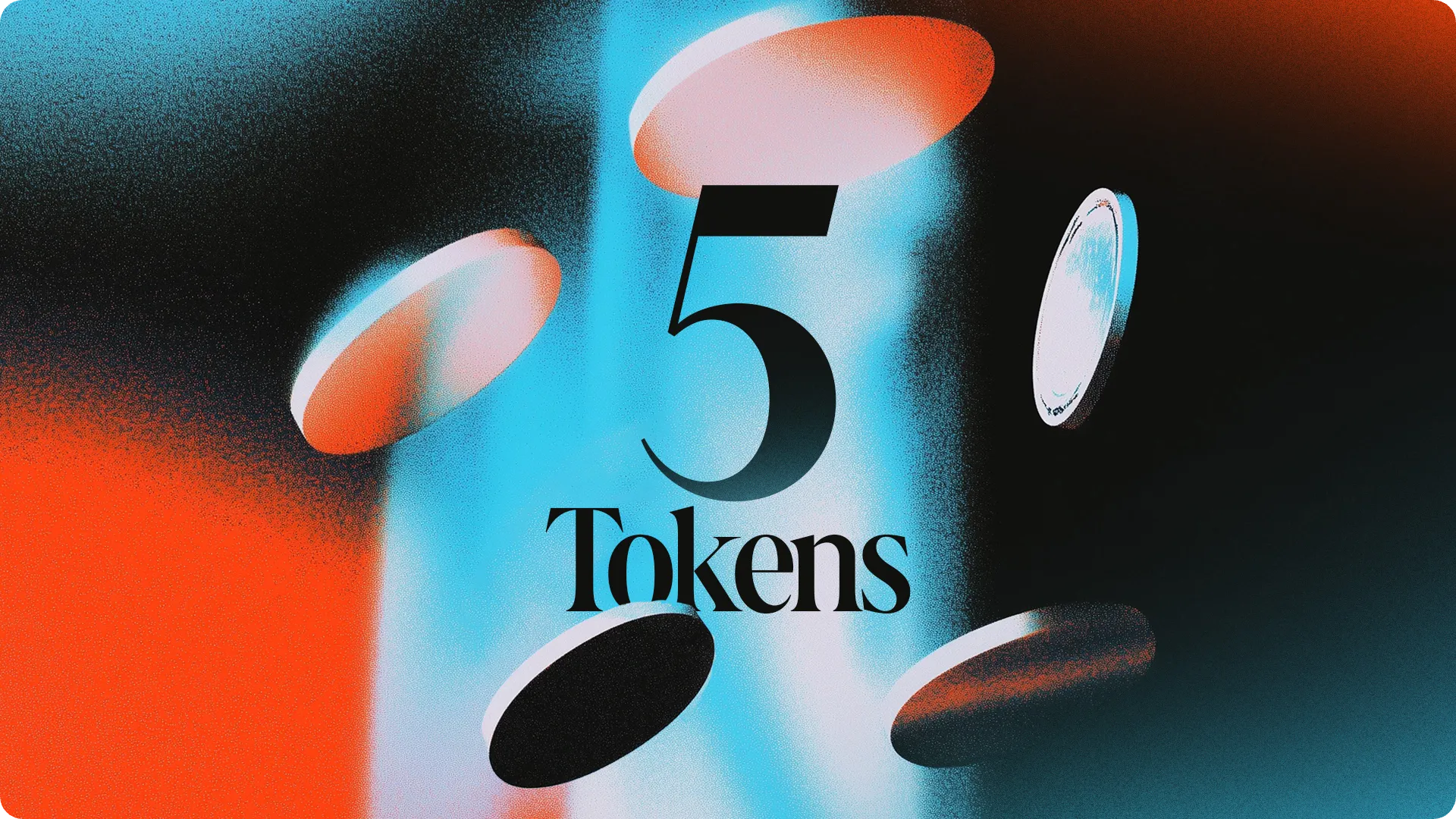5 Tokens Weathering the Macro Storm

While BTC is down 15%, ETH has cratered 53%, and SOL has slumped 40% over the last 90 days, a handful of tokens have managed to go the other way — not just surviving the chop but outperforming nearly every major.
These aren’t random moonshots, either. Each comes tied to a growing sector narrative, funding from prominent VCs, and traction that hints at something more durable beneath the surface.
So while most of the market bleeds, these five tokens are putting up green candles — and telling us something important about where capital is quietly flowing 👇
1️⃣ MANTRA ($OM)
Up 62% over the past ninety days, MANTRA is a Cosmos SDK-based Layer 1 purpose-built for real-world asset (RWA) tokenization.
Positioned to serve institutions and regulators, MANTRA has leaned into compliance from the start — offering plug-and-play identity modules, automated guardrails, and a native DEX. Over the past few months, they’ve ramped things up with a $108.9M Ecosystem Fund, a partnership with Google Cloud to launch an RWA accelerator, and a real estate tokenization deal with DAMAC Group, a massive real estate conglomerate through which they hope to bring RWAs worth at least $1B onchain. While no deals seem inked yet, the vast majority of the RWAs actually live on MANTRA are in real estate, though only to the tune of ~$74M. They’ve also secured a VARA DeFi license — a regulatory greenlight from Dubai’s Virtual Assets Regulatory Authority — making MANTRA one of the few blockchains cleared to offer DeFi services under a clear legal framework. It’s an attractive credential for institutions seeking regulatory clarity before moving RWAs onchain.
Today, we’re announcing the launch of the MEF - a $108,888,888 million investment initiative designed to propel real world asset innovation, adoption and growth.
— MANTRA | Tokenizing RWAs (@MANTRA_Chain) April 7, 2025
But we’re not doing this alone. We’ve got leading incubators, accelerators and capital partners by our side;… pic.twitter.com/oyeCOJ9QrE
All of this has made $OM one of the hottest tokens in the RWA narrative. Still, there are signs of overheating. The token’s market cap is 58 times higher than the total value locked onchain, while others note that, as the RWA market grows, Ethereum’s dominance as the default chain for tokenized assets makes it harder for niche platforms like MANTRA to stand out long-term — cue Etherealize. Further, there is a lot of community angst over recent airdrop campaigns, with complaints about them changing the criteria and rewards as price surged.
Yet, it remains that MANTRA is one of the most visible names in the RWA space, with big partnerships, fast growth, and strong attention, albeit if not all positive. But with expectations sky-high for RWAs, the real test will be how much traction they actually achieve and how quickly they can reduce the delta between their TVL and market cap.
Leading RWA's $ONDO$CHEX$CPOOL$OM
— 🐧 Pentoshi 🇨🇳 🇺🇦 🇪🇺 (@Pentosh1) February 4, 2025
There will be others, not as established yet. But you can't ignore the current outperformance and the overall direction we are heading https://t.co/wzWWsITb41
2️⃣ Story Protocol ($IP)
Story Protocol, up 40% in the past three months, is an EVM-compatible Layer 1 designed to handle the tokenization, licensing, and monetization of intellectual property — serving one of crypto’s most compelling visions of reimagining the internet for creators, offering better ways to prove ownership, share work, and monetize digitally-native content.
With a $140M raise led by a16z, Story shipped its mainnet in February and $IP token alongside a suite of tools for AI-native licensing, programmable IP contracts, and collaborative monetization. At its core, the protocol aims to make IP remixable and composable — something that feels especially timely as AI ramps up content production and creators look for better ways to defend their work. For some, this is exactly the kind of infrastructure needed to keep pace with the internet and push back against the growing power imbalance between individual creators and powerful AI systems.
Founder @jasonjzhao breaks down the multi-trillion dollar IP market and how AI is rewriting the rules for creators. Including:
— Story (꧁IP꧂) (@StoryProtocol) April 9, 2025
➤ How creators like MrBeast can monetize on Story
➤ Why the future of IP is programmable
Full episode + time stamps ↴pic.twitter.com/5Pgj8pZBIZ
That said, the rollout hasn’t been met with universal excitement. Some think that launching a new Layer 1 in a market already crowded with chains — many of which are still struggling for traction — may be an uphill climb. Funny, I thought the exact opposite...
Further, there are also questions about whether blockchain-based IP systems can make a dent without actual legal backing — a sentiment we echo — and whether the token distribution structure is set up for long-term community alignment.
Still, optimism remains. Supporters point to the massive size of the IP market, growing interest in creator-first platforms, and the early potential for Story to plug into everything from Hollywood to fan fiction. With a narrative that hits at the intersection of crypto, AI, and culture, Story has plenty of tailwinds — even if it still has a lot to prove.

3️⃣ Euler ($EUL)
Up 56% in the past three months, lending protocol Euler’s comeback has been one of the most impressive stories in DeFi.
After a major hack in 2023, the platform has roared back — growing deposits by 1000% in just four months and recently crossing $1B in total value locked, with $430M currently borrowed. It’s now live on eight chains, including recent launches on Avalanche, Sonic, and Berachain, and has rolled out over $750K in user rewards just in the past two months.
Borrowers are showing up in force, which we flagged in our token rating back in January. They’re getting access to more capital than usual without the same fear of getting wiped out during market dips. That’s helped Euler become one of the most used lending apps on-chain, with more of its capital actually being borrowed instead of just sitting idle.
1/ The latest data shows that @eulerfinance yield markets on Ethereum continue to see strong adoption.
— Gauntlet (@gauntlet_xyz) April 3, 2025
The growth coincides with Euler hitting $1 BILLION in TVL ~2 weeks ago too.
Here are some notable changes over the past 30 days.
That said, the experience isn’t perfect. Some users say the interface still feels clunky and confusing. Others have also suggested that Euler’s liquidation engine may be second-rate compared to other protocols like Fluid.
Even so, Euler has quietly become one of the more profitable protocols out there, recently pulling in over $550K in fees in a single week. The team’s been moving fast across new chains and continues to roll out new tools and strategies. What started as a cautious rebuild is starting to look like a full return to relevance — even if there are still a few things to figure out.
4️⃣ Plume ($PLUME)
While still pre-mainnet, Plume — an RWA-specific, EVM-compatible Layer 1 — has been consistently gaining institutional momentum, likely contributing to its 23% gain over the past three months.
In that time, the network has rolled out a series of infrastructure upgrades and ecosystem expansions. It launched Plume Nexus, a data layer to streamline how offchain information moves onchain, and integrated with NestCredit and Elixir, bringing tokenized assets from players like BlackRock and Hamilton Lane into its DeFi pipelines.
Onchain institutional rails into DeFi are finally here.
— Plume (@plumenetwork) January 16, 2025
Plume is now live with @elixir on @NestCredit, enabling institutional Real World Assets (RWAs) from @Securitize, @BlackRock, and @hamilton_lane to enter the crypto economy.
👇 This is ground-breaking because… pic.twitter.com/yf22ZZypfc
That expansion has been matched with interest from major backers. In March, Plume received funding from CZ’s YZi Labs, adding to previous investments from prominent funds like Galaxy, Haun Ventures, and HashKey. Most recently, Apollo Global — one of the world’s largest asset managers — joined as a “strategic” investor. All of this, while over $4.5B in tokenized assets have reportedly been committed to apps building on Plume, with 180+ protocols listed as building ahead of the mainnet launch.
Still, sentiment is split. Some are excited about Plume’s early lead in a fast-growing category and see it outperforming thanks to its traction and real-world integrations. Others worry about its decentralization given the heavy traditional finance backing the chain has accrued, a valid concern even echoed at a high level with $BTC as it’s increased its institutional offerings.
Despite the buzz, it’s clear Plume still has something to prove — not just to institutions but to the broader crypto community watching how it handles its transition into mainnet.
5️⃣ Solayer ($LAYER)
Framed as Solana’s first major restaking protocol, Solayer’s up 38% over the past ninety days as it looks to offer users new ways to earn on their staked SOL by helping secure apps both on- and off-chain.
In February, Solayer launched its $LAYER token — a rollout that came alongside a $22M raise from backers like Polychain, Binance, and Solana co-founder Anatoly Yakovenko, plus a $10M community sale via its Emerald Card. Solayer’s InfiniSVM engine — a hardware-accelerated version of Solana’s virtual machine — reached 330K transactions per second and helped keep transactions running smoothly during January’s Solana congestion. Solayer’s network was praised for maintaining throughput without charging extra fees. The team claims it can scale to 1M TPS, though some skeptics have questioned that figure and pointed to a lack of users as a potential issue.
Continued congestion on Solana makes Solayer and other SVM L2s a natural next narrative
— Sisyphus (@0xSisyphus) January 22, 2025
However, our experience with the rise and fall of Ethereum makes me think it is more likely that a new L1 steps up next as the leader, rather than an existing chain's L2s
Hyperliquid
The project’s sSOL staking token continues to gain traction across DeFi, while its stablecoin, sUSD — backed by U.S. Treasuries — has grown to over $20M in market cap, with some seeing it as a compelling addition to Solana’s RWA push.
Still, community sentiment is split. Supporters point to the team’s deep technical chops, fast product rollout, and growing integrations, saying it’s one of the most promising infrastructure plays in the SVM space, especially given a potential need for Solana to scale. Others are more cautious, looking to Jito’s firm positioning in the market as grounds to accelerate restaking on Solana, as well as dwindling TVL from Solayer, down ~80% from its January highs.
Even so, the token has hit new highs, and the protocol remains active. Whether Solayer keeps its momentum will depend on how it navigates growth while addressing mounting scrutiny.
While most of the market has pulled back, these five have moved in the opposite direction — buoyed not by isolated hype cycles but by narratives, specialization, and serious institutional backing or alignment.
Four out of five are also Layer 1s or infrastructure protocols, not general-purpose ecosystems. And, while they’ve each leaned into their own specialization, RWAs — in one form or another — remain the clearest through line. From MANTRA’s push into real estate to Story’s play for IP and even Solayer’s stablecoin tie-in, the “fundamentals” prospect of real-world assets seem to fair better when markets feel pain. Still, with Ethereum already hosting the bulk of RWA value and several protocols showing signs of overvaluation, the path forward is likely to be competitive.
Finally, another point that all 5 have in common is the scale of their backing. Beyond just capital backing from VCs, many of these, like MANTRA and Plume, have announced partnerships with household names like DAMAC or Apollo. That kind of support has helped them stay afloat — and in some cases, outperform — as broader sentiment falters, potentially signaling noteworthy progress.
However, expectations will likely remain high, and the pressure to execute will only increase if the market turns around. In the meantime, the outperformance of these projects helps us craft a profile of what protocols may be best equipped to weather the storm.
